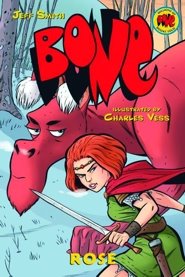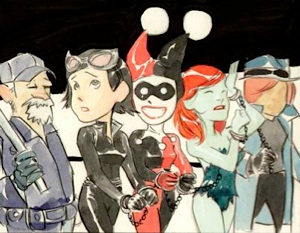Dancing in the aisles at New York Anime Festival

No, really. The energy level here is amazing.
We’ll have more for you later, but man, I am impressed by the reaction.

No, really. The energy level here is amazing.
We’ll have more for you later, but man, I am impressed by the reaction.
 Freshly picked from only the finest and most pedigreed blog bushes, here’s the stuff we didn’t get to yesterday:
Freshly picked from only the finest and most pedigreed blog bushes, here’s the stuff we didn’t get to yesterday:
What’d we miss? Consider this an open thread.
SMALLVILLE Season 9 premieres tonight on The CW and before you tune in, hear just where the year will take us direct from writer/producers Kelly Souders and Brain Peterson and Erica Durance shares her plans for Lois and how she got the “seal of approval” from a former Ms Lane. Plus there are details on DC’s direct to DVD plans and the real “secret origin” of the quintessential Batman, Kevin Conroy.

PRESS THE BUTTONto Get The Point!
And be sure to stay on The Point via ![]() , RSS, MyPodcast.Com or Podbean!
, RSS, MyPodcast.Com or Podbean!
Follow us now on  and
and  !
!
Don’t forget that you can now enjoy THE POINT 24 hours a Day – 7 Days a week!. Updates on all parts of pop culture, special programming by some of your favorite personalities and the biggest variety of contemporary music on the net.
CLICK HERE TO LISTEN LIVEFOR FREE or go to GetThePointRadio for more including a connection for mobile phones including iPhone & Blackberrys
CARACAS, Venezuela – Venezuelan authorities plan to impose fines on cable television companies that refuse to stop airing the animated television series “Family Guy.”
Justice Minister Tareck El Aissami says the program should be pulled from the airwaves because it promotes the use of marijuana.
He said Thursday that cable networks that broadcast “Family Guy” would be fined by Venezuela’s telecommunications regulator if they refuse to dump the program.
And you all know what the folks at Family Guy think about that sort of thing, right?
You don’t? Maestro, take it away…
If you haven’t seen it, here’s the episode in question.
 Jesse Ventura was elected governor, so why couldn’t a costumed mystery man serve in the U.S. Senate?
Jesse Ventura was elected governor, so why couldn’t a costumed mystery man serve in the U.S. Senate?
Paul Kirk, the late Senator Ted Kennedy’s temporary replacement, shares a name but (probably) not the predilection for vigilante crime-fighting, with Manhunter, a DC character with an interesting history.
In the comics, Paul Kirk used decides to become a crimefighter when his friend, Empire City
police inspector Donovan, was murdered by the supervillain known as the
Buzzard. He wore a superhero-like red costume with a blue mask. While
he had no superpowers, he was an above average athlete and possessed
superior tracking skills. Later, he went off to become a big-game hunter, but was killed by an elephant, then brought back to life by a secret society intent on ruling the world (insert obligatory Obama/ACORN reference here) and set up to lead an army of clones of him, but he rebelled and brought down the Council in a story chronicled by Archie Goodwin and Walt Simonson.
That doesn’t seem to describe the real-world Paul Kirk, but who knows? He could be a man of hidden talents.
Or it could be yet another one of those Paul Kirk clones running around…

There was a lot going on today, so let’s see if we can get these Quick Picks done in ComicMix Six words or less.
What was missed? Comments are open.
 Rose
Rose
Jeff Smith & Charles Vess
Graphix, 140 pages, $10.99
Earlier this year, Scholastic’s Graphix imprint completed releasing the nine volumes comprising Jeff Smith’s delightful [[[Bone]]. The full-color books are ideal entry points into graphic novels or even fantasy literature. Now, the prequel, [[[Rose]]], is finally joining the library in a softcover color edition.
Rose is, of course, Gran’ma Ben, the strong, cow-racing elder figure introduced early in Smith’s saga. Her sister, Briar, is The Hooded One, an evil crone, but as we’re about to learn, they were once young and far more carefree.
Illustrated by Charles Vess, the story is very, very different from Bone, much more a cautionary tale and almost devoid of the humor that kept Bone such a great read. Instead, the book focuses on Rose and Briar, both in training to become leaders of Atheia. Rose is exceptionally strong but not at all focused, prone to distractions while Briar is disdainful of her more popular sister, insisting Rose will be the chosen one. When they journey to Old Man’s Cave for the final testing, the young women are drawn into the Lord of the Locusts’ attempt to achieve freedom from its stone prison.
Smith’s story works on many levels, starting with the relationship between the sisters, which rings true. The responsibilities that comes with being princesses weighs heavily on both and where Briar accepts them with solemnity, Rose struggles to follow her muse. Accompanied by her favorite dogs, with whom only she can converse, she seeks adventure wherever she goes. That includes the cave and the final testing, which turns out to be a struggle between Rose and a freed River Dragon, which now threatens the residents in the Northern Valley.
Rose has to make a promise early on and then live with the consequences of that obligation at story’s end and how it shapes her personality, which sets up the more familiar Grandma figure.
Vess, a highly celebrated fantasy illustrator, adapts his lush style to Smith’s world so the Red Dragon is a visual link to the Bone series. His color work is subtle and helps establish this as a related work.
There’s a reason Neil Gaiman said, “A magnificent prequel to Jeff Smith’s Bone, but it’s more than that – – it’s a beautifully painted meditation on magic, on the mistakes of youth and the little personal tragedies that grow to decide the fate of nations and to engulf the world.”
Unlike Bone, Rose is a bit more graphic in its violence and is probably not for the youngest of readers but is highly recommended to everyone else.
 If you need further proof that we here at ComicMix love you and want you to be happy, check out these, our Quick Picks of stuff we didn’t get to yesterday.
If you need further proof that we here at ComicMix love you and want you to be happy, check out these, our Quick Picks of stuff we didn’t get to yesterday.
What else did we miss? Consider this an open thread.

Asterios Polyp
David Mazzucchelli
Pantheon, July 2009, $29.95
Comics are an essentially mongrel art, bred out of the
scraps of two prior art-forms in the great kennel of popular culture. That’s no
bad thing, despite what the mandarins might say – mongrels typically have the
strengths of both parents, without the fussiness and decadent weakness
characteristic of arts that only breed incestuously. Of course comics then are
called bastards, which is both a slander and absolute truth. The slander only stings
if one thinks being a bastard is a bad thing.
Asterios Polyp, for example, is a bastard, and the graphic
novel that bears his name is – and this is only one of the things it is, but we’ll start there – the story
of how he finally, much too late in his life, learns how not to be quite so
much of a bastard as he was before. We see Asterios in appropriately classical
form: both before and after his downfall, as if he’s both at once. More
importantly, though, [[[Asterios Polyp]]]
is the story of comics themselves, as it dramatizes the interplay of the
elements that come together to make up comics. Asterios is a renowned teaching architect:
serious, linear, dogmatic, didactic, Apollonian, a maker of dichotomies. And he
comes up against the Dionysian side of the world again and again, symbolically
ramming his axe-shaped head into the places where the world doesn’t fit his
categories, willing it into the forms he’s decided are right for it.
 Remember Howard Chaykin’s American Flagg? Roy Crane’s Buz
Remember Howard Chaykin’s American Flagg? Roy Crane’s Buz
Sawyer and Captain Easy? Alex
Toth? How about much of that beautiful black and white art in Warren’s
magazines Creepy, Eerie and Blazing Combat?
The one thing they all had in common – along with a hell
of a lot of other great art – is the fact that they were drawn on Duoshade
boards. That’s a certain rather expensive type of paper that allowed an artist
to brush a developer solution over an inked drawing creating different types of
horizontal lines for shading. Originally, they boards replaced the painstaking
task of cutting and pasting the effect onto the original art. It allowed certain
types of dramatic shading and feathering techniques (that’s a line that
consists of teensy tiny lines, giving a softer edge to that line).
Note my use of the past tense.
Now Graphix, the company that makes Duoshade boards (as
well as the Unishade boards, which is a similar type of stuff) has discontinued
production because production has grown more difficult and costly to produce
and demand as declined over the years. Younger artists use their computers –
not necessarily a complete substitute – and many are unaware of the existence
of the product.
Sadly, this comes at a time when the reproduction of comic
art in America has never been better. In the past, some of these types of
effects would close up or turn to mud. With better printing and better paper,
Duoshade – when properly used – gave us some beautiful artwork.